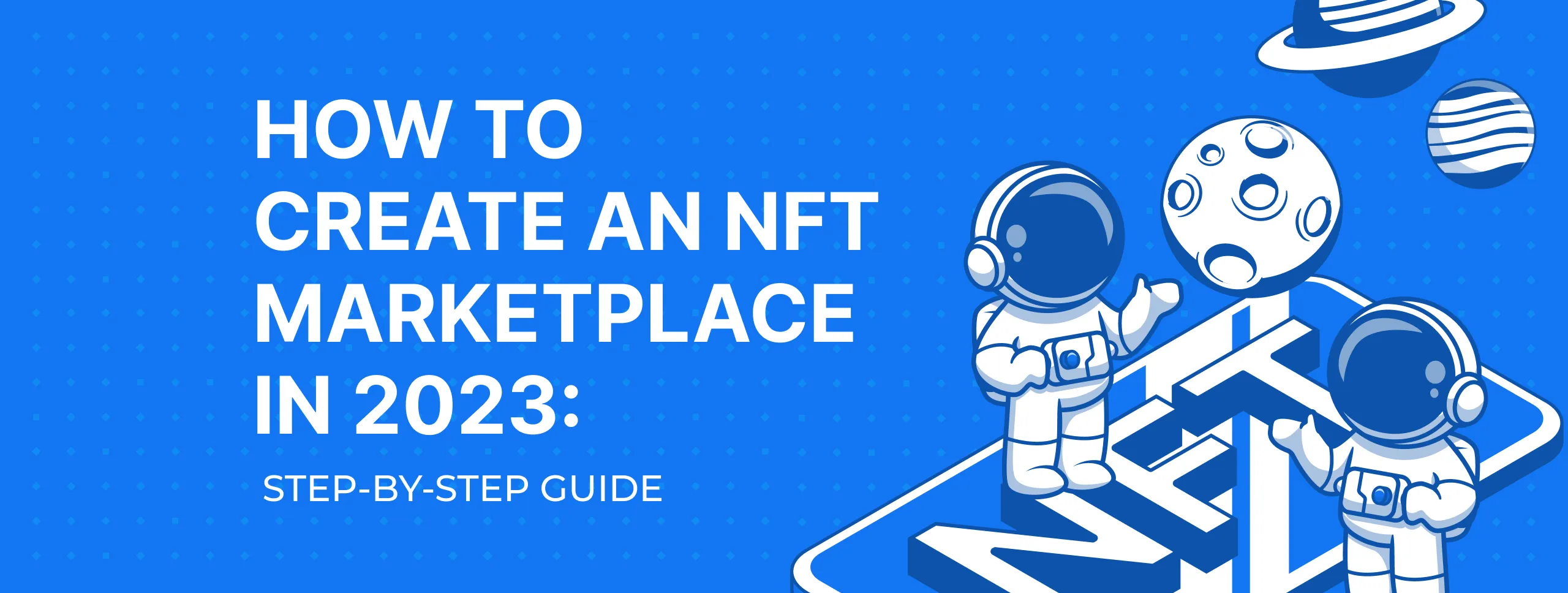
How to Create an NFT Marketplace: Features, Types, and Cost

Table of contents
- What are NFTs?
- Properties of NFT Tokens
- What Is an NFT Marketplace?
- How Does an NFT Marketplace Work?
- NFT Marketplace Trends
- How to Create an NFT Marketplace: Step-by-Step Guide
- Technology Stack for NFT Marketplace Development
- How to Make Money with NFT Marketplace?
- Top 5 NFT Marketplaces
- How Much Does It Cost to Create an NFT Marketplace?
- Cost estimation at Magora and Case Studies
- FAQ
- Final words
One of the key elements that will lead you to success is experimenting and learning something new. Getting stuck in the swamp of comfort may finally steal your opportunity for business growth. Let’s break new ground together by exploring the world of NFT with Magora. Particularly as 75% of US adults are still slightly aware of the NFT market, it is a great opportunity to be among the first to put down roots there.
The whole NFT sector is quite young and dates back to 2014, when Kevin McCoy minted the first NFT called Quantum. Since then, the NFT market has undergone powerful changes and has mushroomed to an impressive size. The year 2021 closed with a peak volume of £20.5 billion, which was 400% growth compared to the previous year. Though there were declining periods and drops in prices, 2022 was still able to fly high.
Anyway, such a ubiquitous phenomenon as NFT is a promising financial instrument that expands the blockchain’s horizons. In this article, we will disclose how to launch an NFT marketplace and discuss why it is a wise decision.
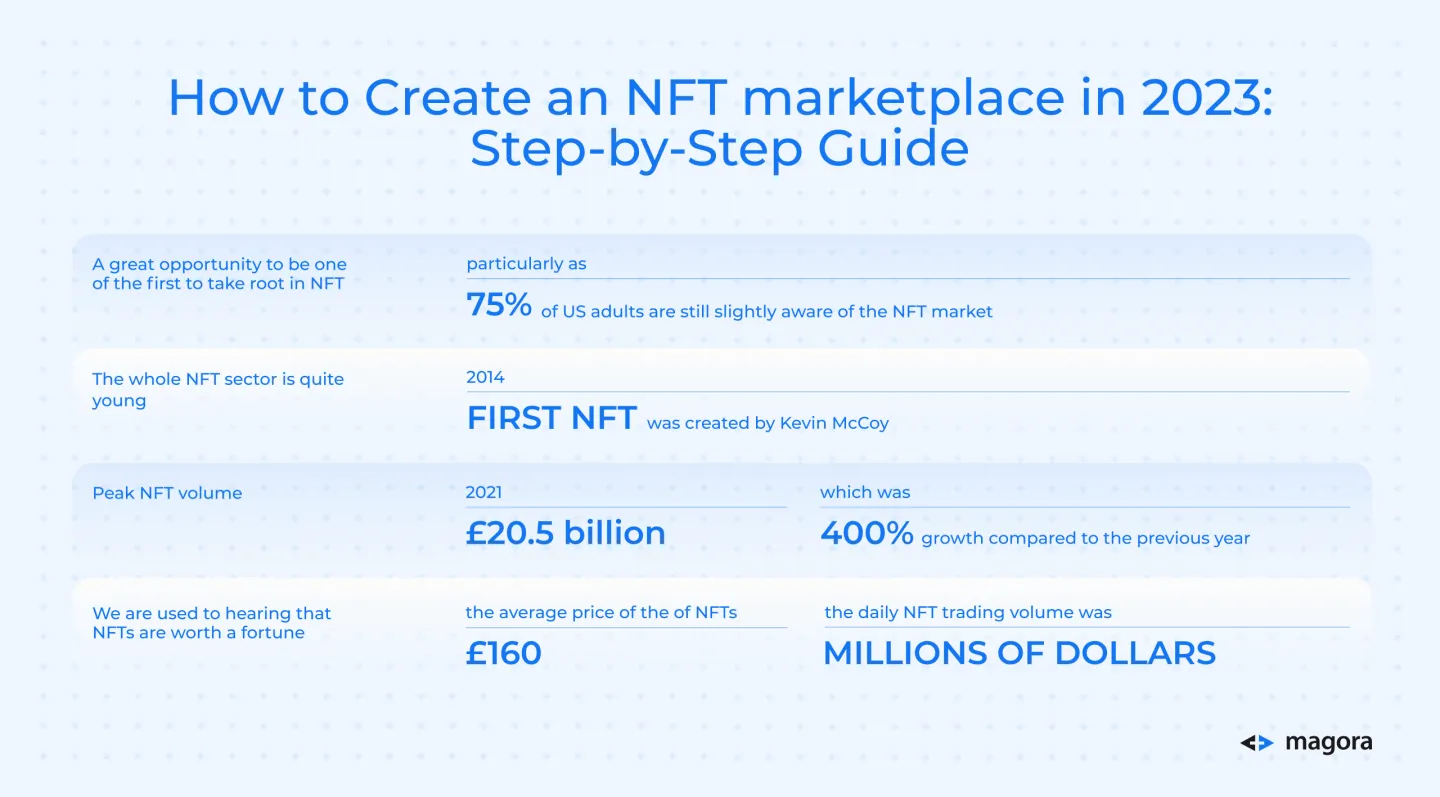
What are NFTs?
NFT, or Non-Fungible token, is a type of cryptographic token, each sample of which is unique like a snowflake and cannot be substituted. In other words, it is a digital certificate that is stored on the blockchain and ensures the originality of a virtual asset and the right to its ownership. As an example of possible assets, this may include artwork, tweets, photos, and real estate. In contrast to cryptocurrency, NFTs have unique value, which is why they cannot be replaced or exchanged for one another. It is important to mention that NFT doesn’t prevent the object from copying. We are used to hearing that NFTs are worth a fortune regardless, even if it is a piece of history like the first tweet (sold for £2.376 million), the GIF with an animated flying cat (sold for £480,000), or an odd idea like the first digital-only fragrance (sold for £14,700). However, the average price of the majority of NFTs is less than £160. That being said, the daily NFT trading volume was millions of dollars.
Properties of NFT Tokens
Authenticity
In the digital world, NFTs function as proof of ownership, and their authenticity can be determined through the provenance.
Non-interchangeable
You wouldn’t care if I gave you a £50 banknote instead of yours of the same denomination. But I can’t hang my Mona Lisa instead of the real one in the Louvre. The same is true of NFT—they have a unique set of metadata and cannot be replaced.
Integrity
NFTs cannot be divided into smaller pieces; otherwise, they will lose their original value.
Traceability
NFT’s great opportunities lie in its ability to provide precise traceability control, as NFT is hardwired to keep essential data such as owner, creator, and other details that can be simply verified.
Interoperability
There are such token standards as ERC-721 and ERC-1155, which enable smooth interaction within a number of blockchain networks simultaneously.
Liquidity
The high speed of trading operations scales up the degree of liquidity. And by “liquidity” here, we mean the accessibility of the buying and selling of tokens.
Programmability
This means the possibility to adjust the necessary functions and modify the appearance of NFT. Moreover, they can be programmed to evolve over time according to the installed instructions.
Portability
You can access your NFT from anywhere using your smartphone or computer. It may be kept in your digital wallet and easily transferred to another country, avoiding shipping, logistics problems, and the risk of damage.
What Is an NFT Marketplace?
NFT marketplaces are based on a blockchain platform or sometimes support multiple of them. They resemble ordinary marketplaces that are familiar to us. An NFT marketplace is a place for e-commerce, ensuring the link between traders, buyers, and crypto assets, while conducting transactions in the most secure manner possible due to the decentralized network. On marketplaces, people sell, buy, store, or showcase NFTs. Moreover, some platforms provide tools for creating (minting) NFT on your own. In order to make a purchase, crypto wallets are needed. An author can set a fixed price for his NFT as well as auction it off. One of the first and biggest marketplaces so far is OpenSea. Its revenue in 2021 amounted to £300 million. The OpenSea marketplace can boast a great variety of NFT collections, including artworks, music, VR items, and photography. For the purpose of attaining success in NFT marketplace development and turning a profit, it is not obligatory to operate with large sums of money and great sales volumes. There are two types of NFT marketplaces: standard and niche. As a matter of fact, the second group is in greater demand, as specific types of NFT have their own target audience.
How Does an NFT Marketplace Work?
Even if there are many different NFT marketplaces, each with their own peculiarities during the operating process, the core working principles are more or less the same.
- The first is a user login system. All newcomers need to go through the authorization process. Your crypto wallet will be connected to your account in order to conduct purchases using cryptocurrency and to store NFTs that you have purchased.
- Right after, you can mint your NFT by downloading the necessary item and adjusting all descriptions and properties. Choose the blockchain, set the price, or put it up for auction. The second option gives you the possibility to accept or decline the bid. Now just wait until everything is checked by the moderator.
- Check the rules for the fees that each platform has.
- List selected NFTs for sale. The selling process will start with the creation of a secure smart contract. Since there is approval for the transaction, the NFT transfers to the buyer’s wallet.
NFT Marketplace Trends
Time and again, new NFT tendencies are creating a buzz. So that you have an edge over competitors, it is good to ride these trend waves and be abreast with the latest influences. Let's cut right to the chase.
Fractional NFTs
What if you were offered to buy the first tweet for the price that is suitable for you? And own a part of history. That has become possible due to the Fractional NFT (F-NFT) technology. The concept of sharing ownership has reached the Web-3 space. This process of “breaking” the NFT is a workaround to divide the indivisible and it looks like an equity participation agreement. This type of cooperation already exists in the traditional financial system as partial possession of an expensive car, aircraft, or luxury villa. Thanks to this manipulation, it is possible to attract a wider audience as the entry cost goes down.
NFT and games
The next case has a more usual model of NFT implementation. It is a so-called Play-to-Earn model, where players get NFT assets as a prize. People play and receive tokens that can later be changed for real cash. NFT in games promotes the development of the whole gaming industry. Such games as Axie Infinity (AXS) or Genopets (GENE) have already applied this model.
NFT and TV industry
Maybe you have already heard about the GenZeroes series by House of Kibaa? It is the first NFT-powered content on TV that, in the future, is able to change the whole industry. By gaining NFTs, the audience becomes more engaged and the way monetization works also transforms. The universe of the GenZeroes series extends to comics, collectibles, and, if your NFT level permits, a share in the show. So, it turns into a good investment.
NFT and music
In addition to minting an album as NFT and selling it for a decent amount of money, there is a good example of another NFT usage. Band Royalty NFT is a platform that helps musicians earn their income every time their song sounds on a playlist.
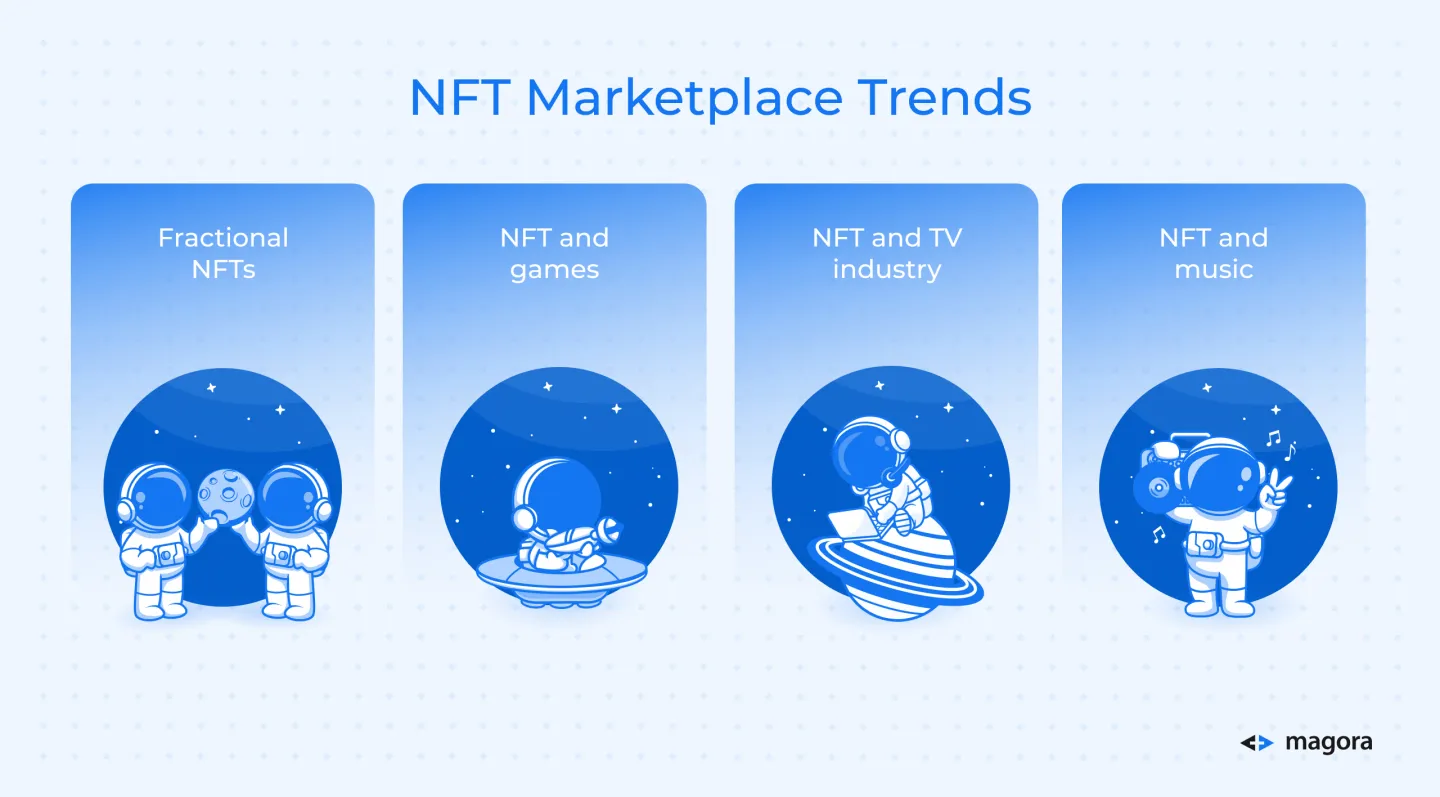
How to Create an NFT Marketplace: Step-by-Step Guide
The development process of cutting-edge technologies such as NFT marketplaces can sometimes be arduous, but let’s make it a positive experience. Here we are to help you out and share our best practices and expertise. Hereafter, we elaborate on the basic stages that enter the NFT marketplace development procedure.
Step #1: Discovery phase
We cannot stress enough how important the initial part of the development process is. Competent and profound preparation sets the tone for the whole project. That is why it is crucial to answer the following questions concerning the project:
- What market niche will you choose?
- What is your target audience? When and where will they use your app, and other detailed preferences?
- Where will the revenue come from?
- What technology stack is better to implement?
- What are the key elements of the project that distinguish it from competitors?
- What blockchain will be most suitable for you?
- What feature list is best for your app?
- What pitfalls will there be, and how can we prepare to mitigate the consequences?
And also, the discovery phase completes some organizational issues like potential expense and time frames. With Magora, you will have all the essential documentation on hand.
Step #2: Create a UX/UI Design
The first seconds influence whether the user is going to stay in your marketplace or leave for another one. That is why it is of great importance to focus on catchy, high-quality, and logical design with seamless functionality.
Step #3: The development process
All issues related to the technology stack will be addressed at this stage and laid at the core foundation of your future app. Depending on your preferences, programmers will start writing code. Smart Contract Technology requires an experienced team in order to avoid bugs and ensure the perfect workflow of your marketplace.
Step #4: Testing
Now it is time to check the app for errors and measure your expectations against reality. QA engineers run testing cycles many times to be sure that the app functions correctly and errors won’t hamper its performance. Upon completion, the app is ready to be put on the market.
Step #5: Implementation and Support
Now we are at the point where we have sought to launch an NFT marketplace. Collecting feedback will help with future app improvements. Magora will help you with post-launch maintenance. We are open to collaboration for any further consultancy services over a long time horizon.
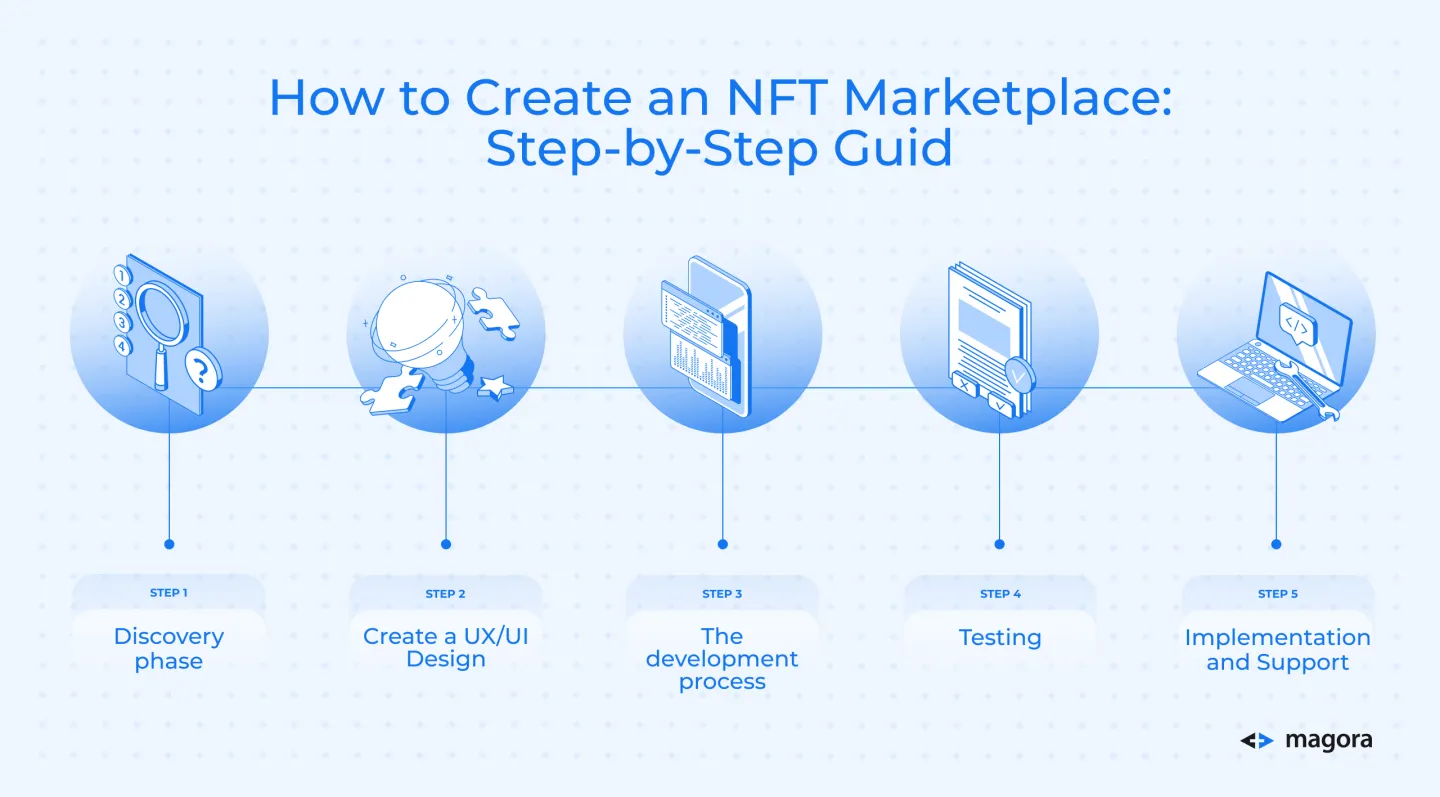
Technology Stack for NFT Marketplace Development
A technology stack is all the technologies, frameworks, and tools to which developers resort to dealing with the NFT marketplace development process. For example, it could be coding, blockchain, or security management. As the technology stack affects the quality of an app’s performance, its future growth and maintenance, as well as its cost-effectiveness, it is necessary to approach this question responsibly and choose the proper set of technologies.
Luckily, our team is ready to figure out what's what and select the best option. Below we give a list of the tech stacks that we use at Magora, including the most efficient and reliable ones.
Need to be checked for Magora’s compliance
| Programming languages | Java, PHP, Kotlin, Solidity, Swift, Typescript, Objective-C, Ethereum Virtual Machine (EVM) |
| Frameworks | React.js, Express.js, Node.js, Angular.JS, Backbone |
| Databases |
SQL: MySQL, PostgreSQL NoSQL: MongoDB |
| Cache | Redis, Memcached |
| Search engines | Elasticsearch, Apache Solr |
| Blockchain | Ethereum, Binance Smart Chain, Flow, Cardano, Tezos, Solana |
| Token standard |
Ethereum: ERC 721, ERC 998, ERC 1155 Binance Smart Chain: BEP-20 Flow: Flow-NFT Cardano: CIP 25 – NFT Metadata Tezos: FA2 Solana: SPL |
| Smart contracts | Ethereum Virtual Machi, Drizzle, Ganache, Truffle, Brownie, Hardhat, OpenZeppelin |
| Cloud hosting platforms | Amazon Web Services (AWS), Elastic Compute Cloud (EC2), Relational Database Service (RDS), and Simple Storage Service (S3). |
How to Make Money with NFT Marketplace?
Now let’s think about how your idea may generate income.
- Listing Fees. Since there are millions of NFT items minted on the marketplaces, it is a critical task to categorize them all into groups. This will make it easy to find the necessary asset and reduce time. So, marketplaces charge sellers a listing fee upon creating an NFT.
- Transaction fees. Every transaction that is conducted in the marketplace is accompanied by a 1%–5% charge.
- Minting fees. The fee that is charged during the NFT creation process.
- Governance tokens. This is kind of a distinctive sign that NFT trading platforms give to their users who make purchases. Such tokens may give their owner the right to take part in the platform's decision-making processes.
- Registration fees. To use this model, your platform should be famous enough and offer an exclusive set of services. Maybe it will even be a closed, privileged club.
- Ads. You may place an advertisement using third-party services or companies or organize promotions for the NFT authors and their collectibles inside your trading system. Blogs and guides will boost your audience and become one more way to generate revenue.
- Bidding charges. This model implies that every participant in the auction must pay a special fee.
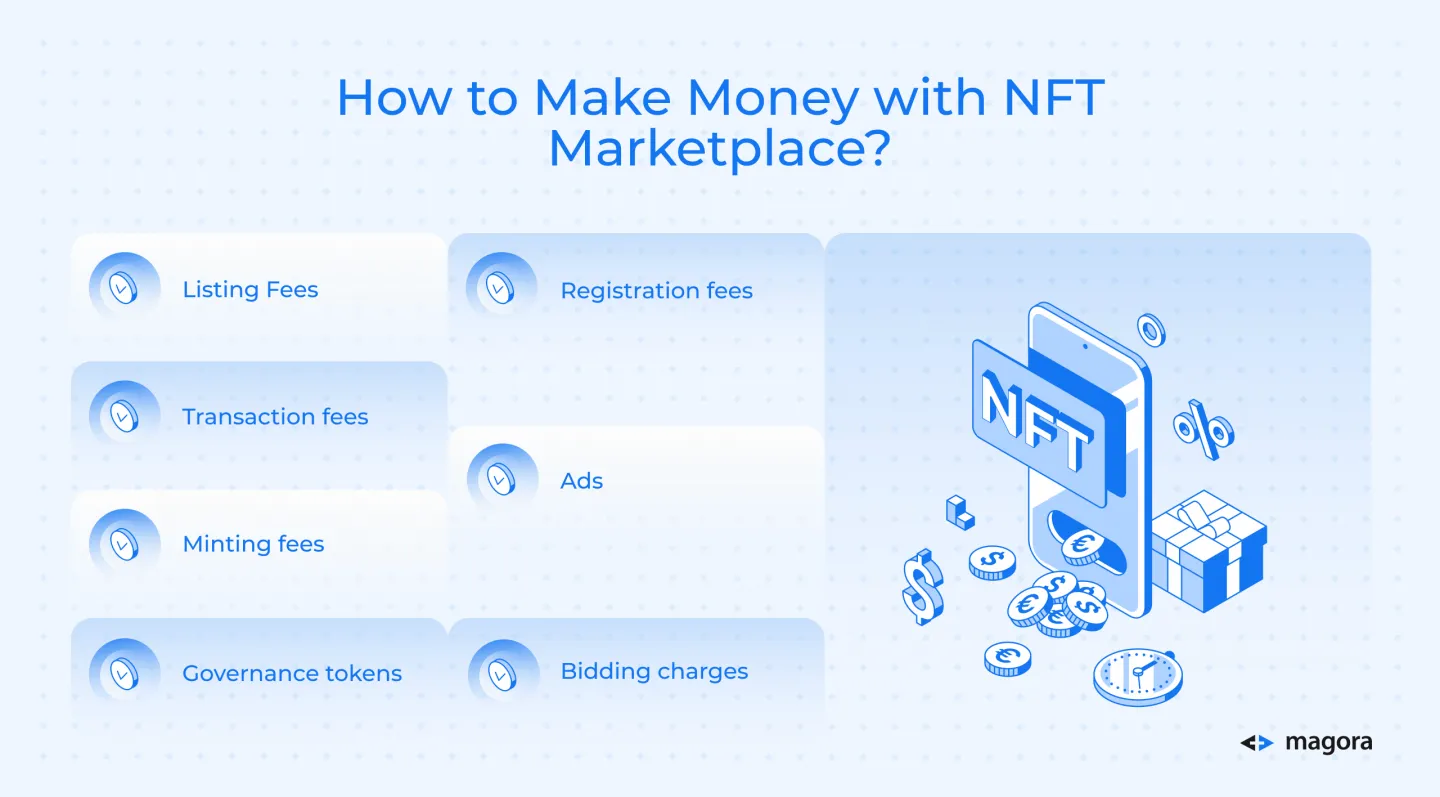
Top 5 NFT Marketplaces
Accubits
It is an NFT marketplace that is focused on the world of sports. The Accubits marketplace provides additional opportunities for sports fans to be closer to their favorite team or athletes. A unique piece of NFT memorabilia created by athletes is a good option to gain extra income as fans can invest in them. In return, loyalty can be rewarded with an entrance ticket for the whole season or VIP seats near the field.
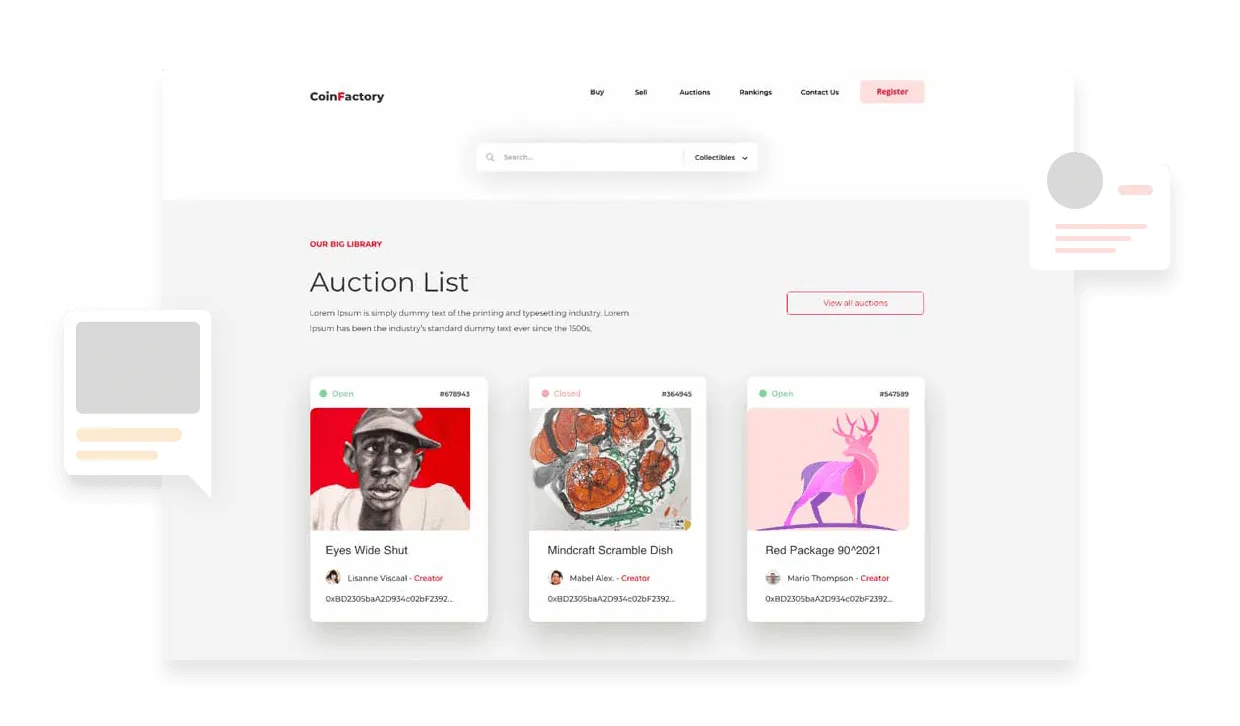
The Axie Infinity
The Axie Infinity marketplace is the best choice for gamers. It is the entire university where you can earn NFTs while playing, as well as buy NFT items, fantasy NFT pets Axies, and land. Although the profit numbers of the marketplace are declining (the top revenue was high around June–July 2021), it still has a decent value and is a good platform to invest in. If you don’t want to win battles yourself, you can lend your pet for a fee. Such cooperation is called a scholarship. While there is no buyer's fee, sellers pay 5.25% of each transaction.
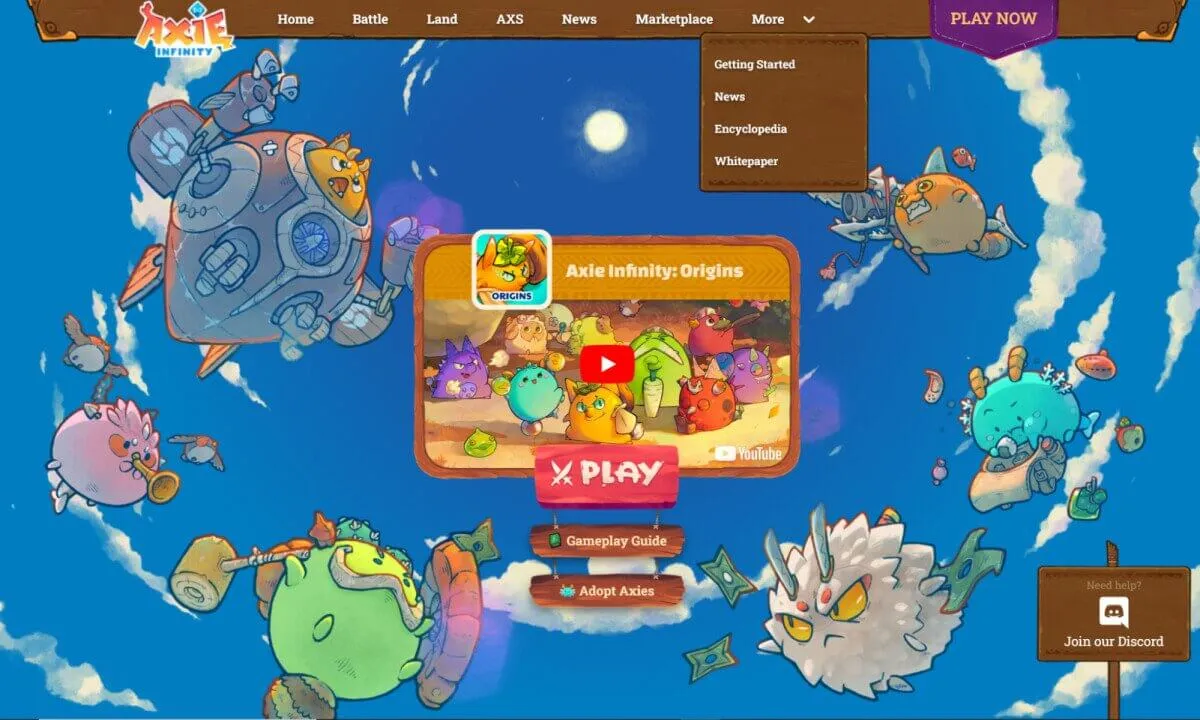
SuperRare
It is a high-end digital art marketplace where top artists create, buy, or sell rare kinds of NFT assets. The important peculiarity of SuperRare is continuous royalties. The revenue share goes to artists for all secondary sales. Spaces are independent galleries established by creators or collectors that are presented on the market. They are entitled to attract new artists from outside, hold sales, and set charges.
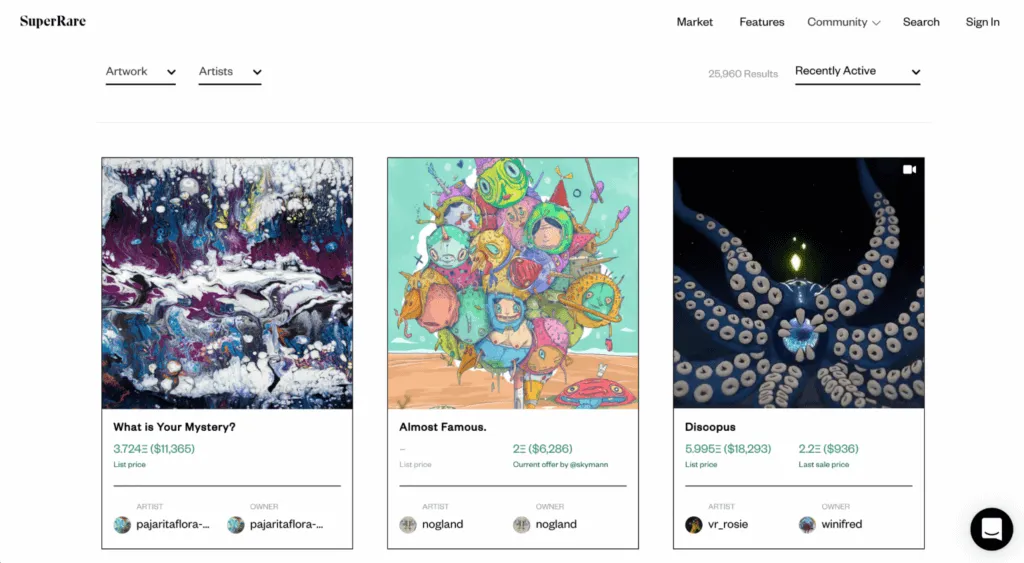
OpenSea
None of the “best marketplace” lists is complete without the largest marketplace OpenSea. The choice of suggested NFT items is great: art, domain names, music, gaming assets, and numerous other things. There is a minting tool to create your own NFT, as well as buy or sell already existing ones. The platform is comparable to a variety of blockchains: Ethereum, Solana, Polygon, Klaytn, Arbitrum, and others. OpenSea receives a 2.5% fee from the sale price. Also, there is a gas fee paid to validators on Ethereum.
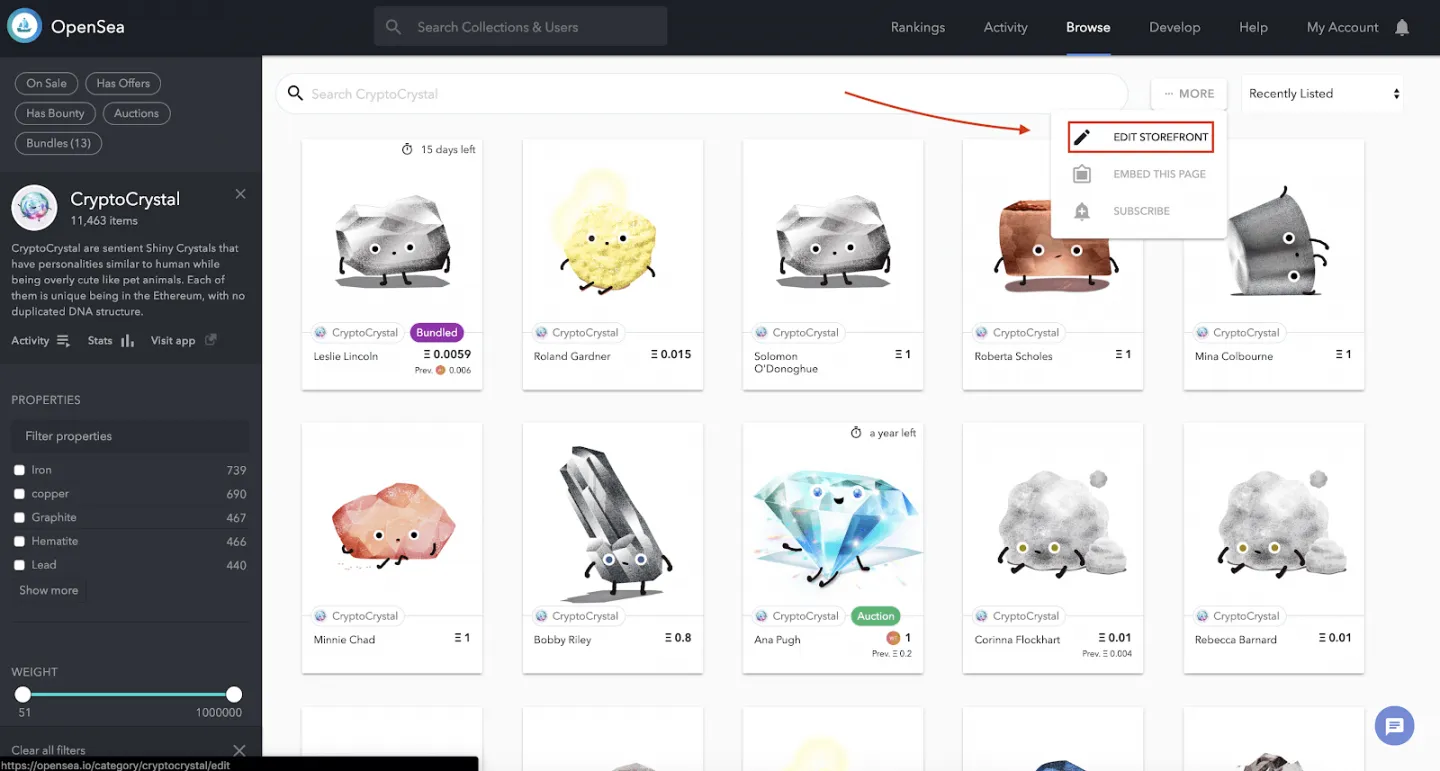
NBA Top Shot
NBA Top Shot is another sports trading platform that is licensed by the National Basketball Association. Here, basketball enthusiasts can be the owners of sports history. Great moments, cards with favorite players, and videos are available for purchase, sale, and collection. There are also challenges and quests completed of which are rewarded by the prizes. The more rare moments there are, the higher the price is. For example, there were moments of Giannis Antetokounmpo’s block in the NBA Finals. The seller has to pay a 5% fee for each item sold.
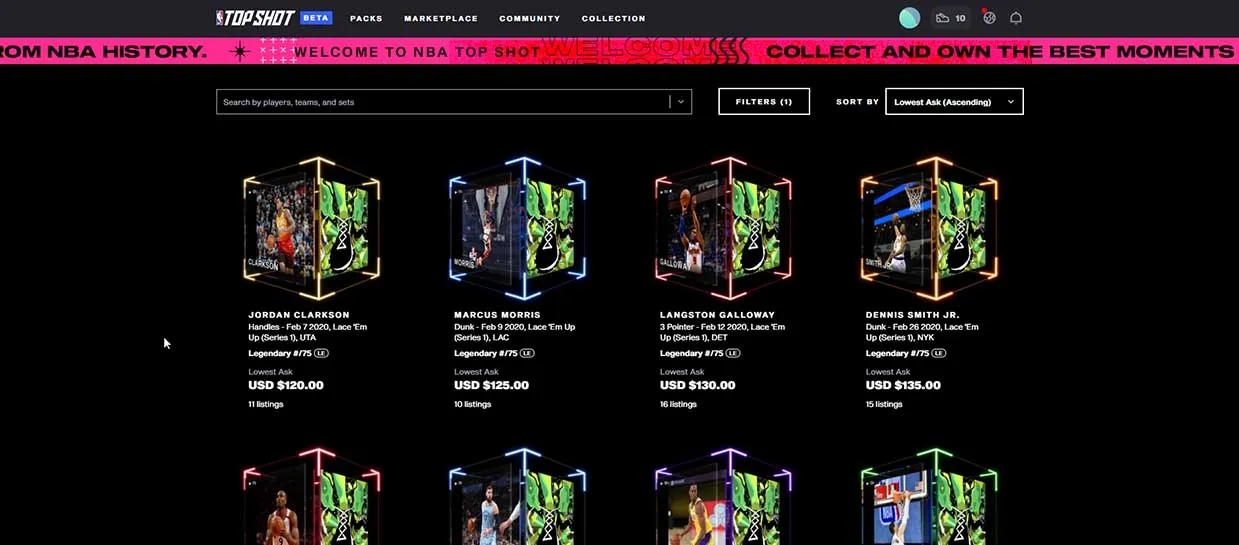
How Much Does It Cost to Create an NFT Marketplace?
The NFT marketplace development process is made up of many different aspects, each of which can add a couple of zeros to your cost estimation. The approximate cost of a trading platform may vary from £40,000 to £410,000. The numbers are rough, but no one will tell you the exact sum, as every development project like an NFT is unique.
For your benefit, let’s name a few of them:
- your app or web app customization level;
- the complexity of the technologies implemented;
- the platform for which your marketplace will be created (iOS, Android, cross-platform, web app);
- the uniqueness of UI/UX design and branding elements.
A lot depends on your development team, namely its location, as the prices vary from £25 to £164 per hour from country to country. Moreover, the type of cooperation also affects the expenses and the whole workflow. You may choose to hire an in-house team, freelancers, or an outsourcing company. Each option has its pros and cons. We recommend you check out our previous article to find out the details on how to hire mobile app developers. Returning to costs, here is our advice to reduce them significantly: build an MVP (minimum viable product) first. This is the version with just core functionality that helps to check the feasibility of the idea and get fast feedback.
Cost estimation at Magora and Case Studies
At Magora, we cherish our clients and are pleased to provide a blow-by-blow cost structure, including time frames and different strategies for mitigating risks. We have no intention of inflating the budget bubble and recommend the solutions we strongly believe in ourselves.
FAQ
How much does it cost to build an NFT marketplace?
A rough estimation of the cost of NFT marketplace development starts at £40,000 and climbs to £410,000. And yet, bottom-line prices largely depend on the next few factors:
- technology stack;
- third-party integration;
- UI/UX design quality;
- the app’s customization;
- the number and complexity of features.
How does an NFT marketplace generate profit?
Besides the fact that NFT marketplaces are very popular and still have a huge potential for growth, there are several standard variants for the generation of revenue flow: listing fees, transaction fees, minting fees, registration fees, bidding charges, and advertising.
What do I need to create an NFT marketplace?
In order to create an NFT marketplace from scratch, you need to endure the whole development process stages such as the discovery phase, design creation, frontend and backend development, QA testing, and, finally, launching. This journey is better to go through with pleasant company like Magora’s great team.
Final words
As you can see, the NFT market is not going to stop growing but quite the opposite. So it is wise to jump on board this rushing train and be in the thick of things. We are ready to move forward with your NFT marketplace concept and collaborate to create an upscale, robust product. People are still exploring the practical use of NFTs, and we are sure that great opportunities are hiding from our eyes. So, NFT trading platforms are a wonderful chance for your business to expand and reach new heights. Magora will undertake all the challenges that arise during the whole development process. Let us know if you have an NFT marketplace idea and we will provide a complete consultation for you





